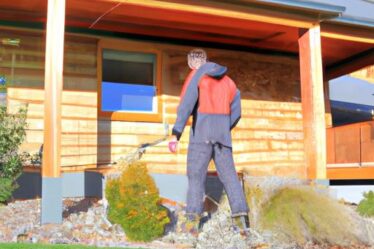Introduction
When it comes to maintaining a lush and healthy lawn, weed control plays a crucial role in ensuring your outdoor space remains vibrant and thriving. But what exactly is weed control in the context of lawn care? Essentially, weed control involves the management and elimination of unwanted plants that can disrupt the beauty and health of your lawn.
Maintaining a weed-free lawn is not just about aesthetics; it also contributes to the overall health of your grass. Weeds can compete with your grass for essential nutrients, water, and sunlight, ultimately weakening the turf and making it more susceptible to diseases and pests. By understanding the importance of weed control, you can take proactive steps to keep your lawn looking its best year-round.
Common Types of Weeds in Lawns
Broadleaf Weeds
Broadleaf weeds are characterized by their broad, flat leaves and typically have a higher tolerance for a variety of conditions compared to grassy weeds. Common examples of broadleaf weeds include dandelions, clover, and chickweed. These weeds can quickly spread and take over your lawn if left unchecked, making it essential to identify and address them promptly.
Grassy Weeds
Grassy weeds, as the name suggests, resemble grass in appearance but are undesirable in a lawn setting. These weeds can disrupt the uniformity of your turf and compete with your grass for resources. Examples of grassy weeds include crabgrass, foxtail, and annual bluegrass. Proper identification and targeted control measures are crucial for effectively managing grassy weeds in your lawn.
Sedges
Sedges are another type of weed commonly found in lawns, characterized by their triangular stems and grass-like appearance. Unlike grasses, sedges have a unique growth pattern and can be challenging to control. Common sedges include yellow nutsedge and purple nutsedge. Understanding the distinct characteristics of sedges is key to implementing effective weed control strategies in your lawn.
Methods of Weed Control in Lawns
A. Manual Removal
One of the most straightforward methods of weed control in lawns is manual removal. This method involves physically pulling out weeds by hand or using tools such as a weeding fork or hoe. Manual removal is effective for smaller infestations and can be a satisfying way to connect with your lawn while maintaining its health. However, it is essential to ensure that you remove the entire weed, including its roots, to prevent regrowth.
B. Chemical Herbicides
Chemical herbicides are another common method of weed control in lawns. These products contain active ingredients that target specific types of weeds while leaving your grass unharmed. When using chemical herbicides, it is crucial to follow the manufacturer’s instructions carefully to avoid damaging your lawn or harming beneficial plants and organisms. Additionally, consider using selective herbicides that target only specific types of weeds to minimize environmental impact.
C. Organic Weed Control Methods
For those looking for a more natural approach to weed control, organic methods offer effective alternatives to chemical herbicides. Organic weed control methods include using natural products such as vinegar, boiling water, or corn gluten meal to suppress weed growth. These methods are environmentally friendly and safe for children, pets, and beneficial insects. While organic weed control may require more effort and persistence, the long-term benefits for your lawn and the environment make it a worthwhile investment.
Preventing Weed Growth in Lawns
Proper Lawn Maintenance
Maintaining a healthy lawn is key to preventing weed growth. Regularly mowing your grass at the appropriate height can help shade out potential weed seeds, preventing them from germinating and taking root. Additionally, keeping your lawn well-watered and properly fertilized will promote strong grass growth, making it more difficult for weeds to establish themselves.
Using Pre-Emergent Herbicides
Pre-emergent herbicides are a proactive approach to weed control, targeting weed seeds before they sprout. These herbicides create a barrier in the soil, preventing weed seeds from germinating and growing. By applying pre-emergent herbicides at the right time, typically in the spring and fall, you can effectively stop weeds in their tracks before they become a problem in your lawn.
Overseeding
Overseeding involves spreading grass seed over existing turf to promote thick and healthy grass growth. By overseeding your lawn, you can fill in bare spots and create a dense turf that chokes out weeds. The new grass plants compete with weed seeds for space and resources, reducing the likelihood of weed growth and helping your lawn stay green and vibrant.
Conclusion
In conclusion, effective weed control in your lawn is essential for maintaining a healthy and vibrant outdoor space. By implementing best practices such as regular mowing, proper watering and fertilization, and mulching, you can create an environment that discourages weed growth and promotes the growth of lush, green grass. Remember, a weed-free lawn not only enhances the beauty of your property but also contributes to the overall health of your turf.
By staying proactive and following the tips outlined in this guide, you can enjoy a weed-free lawn that is the envy of the neighborhood. So, roll up your sleeves, grab your gardening tools, and get ready to take on those pesky weeds. With dedication and consistent effort, you can achieve a weed-free lawn that you can be proud of.

